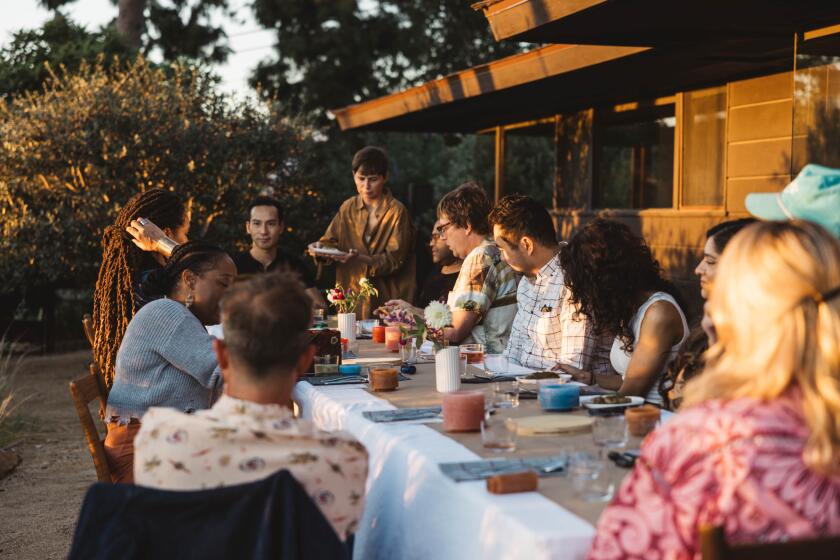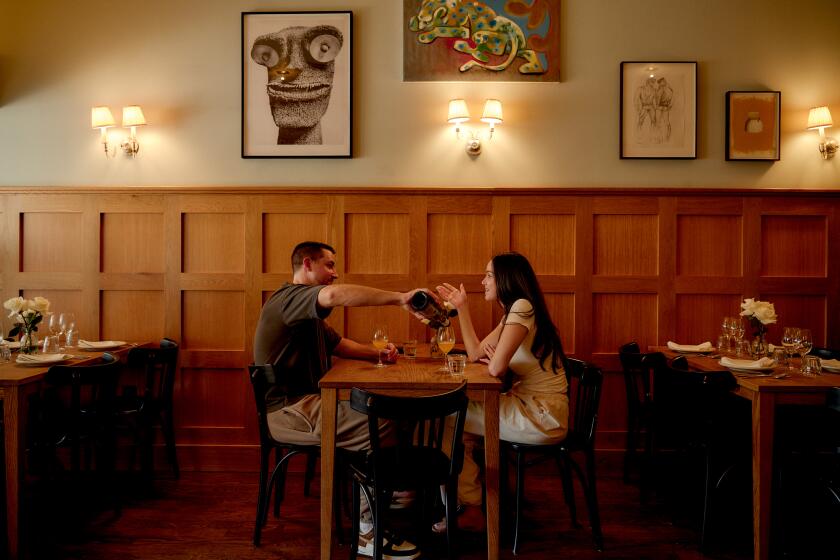In a Year of the Blahs, There Were Also a Few Ahhs on Dining Scene
SAN DIEGO — San Diego restaurant-goers might think of the 1980s as a series of ships that docked long enough to dump catches of exotic fish, each load different from the others and most pretty lively, even if one or two smelled to high heaven.
Each year until 1988 has been marked by a trend, and thus far we have seen the Year of Grazing, the Year of Blackened Fish, the Year of Nouvelle Cuisine and the ongoing, serialized Invasion of the Northern Italians. On reflection, though, the only way to characterize 1988 is as the Year of the Blahs.
The last 12 full moons have highlighted a few notable developments, but there was no unifying trend or theme, unlike past years when diners rushed to be the first on the block to sample sushi, or discovered that spaghetti and meatballs is just a speck of space debris in the whirling universe of pasta. And, unlike years in which young chefs rallied around the standards of California cuisine and the phony, pseudo-Cajun cooking emanating from New Orleans, 1988 rolled along without a discernible cause or course. It was, to be brief, ferociously dull.
The year’s languid flow was interrupted by occasional moments of drama, such as the closing of Gustaf Anders. Vincent’s, which may have been the most significant opening of 1987, went out with a whimper in September, and word came in the final days of December that Sheppard’s, which consistently has ranked among the town’s top five rooms, will also be folding its menu.
These three closings, all of restaurants provoking serious gastronomic interest, may be the nearest thing to a trend that 1988 offered. If so, it would be a disturbing one.
To cast gloom aside, the fact that 1988 adopted such a blase tone may testify to the city’s growing sophistication. The year saw the opening of Brazilian, Caribbean and Romanian restaurants, all of which would have been major news in the days when international cuisines were represented primarily by sweet-and-sour pork and onion soup. But San Diego has become comfortable with Indian, Thai and even Afghan cooking, and, short of a place that specializes in the favorite Mongolian dish of potatoes stewed in mutton fat, foreign restaurants seem likely to find audiences without raising much of a stir.
The brightest light of 1988 glowed pretty much in isolation, since Marius, in Coronado’s new Le Meridien hotel, is unlikely to spawn any imitators. This grand, glorious room is supervised from afar by French restaurateur Jany Gleize, whose two-star La Bonne Etape in Provence is a destination for salivating Frenchmen and tourists alike. His viceroy, Olivier Rispoli, faithfully reproduces such Gleize classics as cold lamb terrine, crab salad in sea urchin sauce, lamb filet in a sauce intoxicated with the essence of fresh thyme, and a sly dessert of grilled pineapple in a silly sauce of caramel, orange juice and black pepper. This is brilliant cooking, but it is too specialized, too personal and probably too expensive to have any impact on San Diego cooking in general. (2000 2nd St., Coronado; 435-3000.)
The two other top openings were both Italian and both in La Jolla. The relatively humble Pasta Place added a room decked in murals and blossomed into Issimo, a slightly eccentric exemplar of good cooking that occasionally lapses into a French accent, but always with charming results. The kitchen treats pasta as if it were a rare delicacy, combines sauteed Vidalia onions with cream in a suave tart, packages creamed forest mushrooms in a box of melting puff pastry and
loads the dessert tray with pastries that come in chocolate, very chocolate and overwhelmingly chocolate versions. Slow service has been a problem here, but is said, by customers and management alike, to be improving. (5634 La Jolla Blvd.; 454-7004.)
An earthier but nonetheless refined approach to the myriad possibilities of Italian cooking characterizes Sante, a happy transplant from New York operated by brothers Tony and Gaetano Buonsante. The brothers encourage special requests and will prepare a creamy risotto a piacere (“according to pleasure”) at a moment’s notice. This is about the only place in town to find genuine scampi, or sweet, prawn-like crustaceans from the Adriatic, and liver lovers will rejoice in both the Venetian presentation, which is accented with onions and vinegar, and a more subtle variation finished with fresh sage leaves. Pastas and veal dishes are uniformly well presented. (7811 Herschel Ave.; 454-1315.)
The North County coastal strip weighed in with several new contenders, although the mushrooming inland cities had to content themselves largely with a proliferation of chain eateries. The chief marvel and envy of North County restaurateurs was Cilantro’s, which opened with the year and found itself besieged by a clientele that returned regularly for its attractive Southwestern cuisine. (That this restaurant’s success has not fostered a boomlet of Southwestern cooking is, in fact, quite surprising.) Cilantro’s is casual but stylish, a situation that North County seems to favor, and the same remark could be made about the cooking, which offers familiar Mexican overtones but avoids the drearier characteristics of most San Diego-style Mexican cooking. The menu presents the possibility of dining on a succession of such appetizers as elegant crab-and-cabbage tostadas; quesadillas with mixed cheeses, roasted chili peppers and the sourish herb called epazote ; pork carnitas wrapped in blue corn tortillas and superb tamales with unusual stuffings. Formal entree choices include excellent fajitas and several unusual seafood preparations. (3702 Via de la Valle, Del Mar; 259-8777.)
Farther west on Via de la Valle, Red Tracton’s opened across from the Del Mar Race Track as a rendezvous for high rollers who believe that a good thing is not quite as good as more of a good thing. A Los Angeles-area fixture for four decades, Tracton’s unapologetically serves immense quantities and takes no prisoners; the remains of one memorably tender steak translated into several day’s worth of sandwiches. Beef, particularly a prime rib worthy of the name, heads the menu, but there are also excellent seafood dishes and some not-to-be-missed sides, such as the wispy fried onion rings and the cottage-fried potatoes, an American classic that has just about vanished from the gastronomic landscape. (550 Via de la Valle, Solana Beach; 755-6600.)
One of the more surprising newcomers was Carlsbad’s Le Marengo, an unquestionably eccentric eatery that occasionally sends its cooks out to wait tables but offers a marvelously varied menu degustation or “tasting menu” of light and wonderfully French dishes. Presentation is as sprightly as the flavors, which fairly leap off the plates. Seafood is the specialty, although not to the utter exclusion of meat dishes, which include veal in a caramel-lime sauce and lamb loin with a garlicky bayaldi (mold) of eggplant, zucchini and tomato. Seafood winners include a charlotte of crab and avocado; a very French version of shrimp ravioli; sea bass baked in puff pastry and smoked salmon-wrapped melon fingers in a light curry dressing. (3050 Pio Pico; 720-0102.)
San Diego added another flag to its international roster of restaurants with Copacabana, a Brazilian-style churrascario that serves what one waiter called “an all-you-can-eat Brazilian meat extravaganza.” The meal starts with salads and progresses to roast beef and pork, both carved at table, as well as chicken thighs, beef kebabs and spicy linguisa sausage. The general idea of the meal is quite attractive, although at the time of a pair of visits the quality of the meats varied markedly. (2888 Pacific Highway; 297-2672).
Romanian cooking also joined the crowd in the form of Bucharest, a La Jolla restaurant of some pretension that offers somewhat unusual versions of moussaka, stuffed grape leaves and cabbage rolls as well as such more specifically Romanian offerings as mamaliga (cornmeal mush with cottage cheese and sour cream), the heavily herbed lamb chops Dobrogea and broiled sturgeon topped with basil butter. The house espresso is flavored with orange and is worth a try. (6737 La Jolla Blvd.; 454-4555.)
Inexpensive full-service restaurants are vanishing fast, although a trio of newcomers bucked that trend and may presage better things in the future. Fifth & Hawthorn (at Fifth Avenue and Hawthorn Street, 544-0940); presents a seafood-oriented menu that offers such oddities as gravad lax sushi, which may be San Diego’s, and perhaps the planet’s, sole example of Swedish-Japanese cuisine. More in the mainstream are the mussel bisque, the oysters baked with herbs and bacon, white sea bass cooked in ginger and soy-scented steam and citrus-marinated mahi mahi.
At Safari (2770 5th Ave., San Diego, 295-0504), the mood is more Cajun, but not annoyingly so, especially in the case of the sweet potato-smoked turkey soup that occasionally turns up as a special. Since this place is partly a neighborhood bar of the more refined variety, there is an excellent pepper steak, a pork tenderloin in a dressy red wine sauce, and, again on the Cajun side, a trout in a delicious roasted pecan sauce.
Willy’s American Bistro (911 Camino del Rio South, 692-0094) brings good, plain cooking to Mission Valley, a neighborhood that sorely needs it. Barbecued back ribs and smoked beef brisket both are savory and satisfying, a remark that applies equally to a hamburger patty coated in peppercorns and finished with a red wine sauce; this is an admirable sort of “poor man’s” pepper steak. Desserts are rich and filling and hard to pass by, especially the creme brulee and the warm bread pudding in whiskey sauce.
On a final note, the closing months of the year brought a couple of happy additions to downtown’s growing roster of interesting eateries.
515 Fifth (515 5th Ave.; 232-3352) occupies the site of the pioneering Morgan Restaurant, one of the first restaurants to venture into the Gaslamp Quarter. The place is a touch avant-garde in its mood, but solidly haute in its cooking, which runs from such elegant staters as fried Brie with watercress and pears, and pasta tossed with prosciutto, grapes and Stilton, to imaginative entrees such as a veal chop finished with Camembert and grilled swordfish garnished with a three-pepper relish. Young chef Gunther Emethinger sends out astonishing pastries, including a glamorous three-layer round of white, milk and dark chocolate mousses.
Just a few blocks up the street, the Fifth Avenue Bistro (Horton Park Plaza Hotel, 901 5th Ave.; 231-0055) offers a much less imaginative menu, but serves it up along with live jazz in a beautifully refurbished room. California-style pizzas and pastas weigh in as among the better choices on a list that also includes Dover sole meuniere and roast duck in red currant sauce. The restaurant also offers a lighter, after-theater menu that is served until midnight.
More to Read
Eat your way across L.A.
Get our weekly Tasting Notes newsletter for reviews, news and more.
You may occasionally receive promotional content from the Los Angeles Times.










